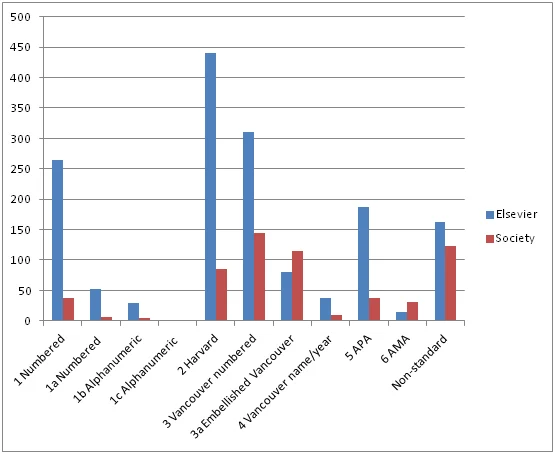Editors' Update - supporting editors, every step of the way.

很遺憾,我們無法支援你的瀏覽器。如果可以,請升級到新版本,或使用 Mozilla Firefox、Microsoft Edge、Google Chrome 或 Safari 14 或更新版本。如果無法升級,而且需要支援,請將你的回饋寄給我們。
我們衷心感謝你對這個新體驗的回饋。告訴我們你的想法 打開新的分頁/視窗
2020年3月20日
Elizabeth Przybysz

Is it really so important?
According to the National Information Standards Organization1, references perform two essential functions in research and publishing: they ensure that credit is given to the people and organizations whose previous works have contributed to that research, and they enable users of the references to uniquely identify and locate the original data and source the materials used.
What does this mean in today’s world? Fewer and fewer libraries and individuals subscribe to a print version of a journal. Even when libraries maintain a print version, readers access journals electronically. Some may still consult the source cited by visiting a local library, but the vast majority expect to have instant access to cited sources via linking services (such as CrossRef, PubMed, Scopus, or Web of Science) from the journal content platform provided through their institute.
The importance of these linking services does not end there. They monitor and analyze the online traffic, providing information on how many citations an article or an author has received. This not only ensures that the appropriate credit is given to an author of the cited material, but can also measure the importance of that research using various metrics (e.g. total citations, h-index). To provide an accurate picture, it is vital that all references can be tracked and that all sources are accounted for. This can only be guaranteed if an author, preparing the references, provides all the relevant metadata required by the linking services.
Elsevier titles currently follow one of 10 standard styles, conforming to either the numbered or name/date master style; except for approximately 300 titles that follow their own non-standard style. All of these are legacy styles from the print era. Journals follow a particular style used within a scientific community or as a result of an editor’s personal choice. A non-standard reference style can certainly make the journal visually distinctive. However, none of these styles provides the optimal information for the linking services, with negative consequences on the discoverability of articles and authors in the online world. Elsevier has decided it is time to review the references styles from the point of view of meeting linking services requirements.
We discovered that some of the formatting requirements may work against effective linking, or are completely irrelevant. Nevertheless, the reader experience may call for their continued inclusion.
For example:
the Vancouver style presents authors’ initials without a full stop, whereas a full stop is required by linking services to distinguish between multiple authors of an article;
journal titles are not used to match references across databases, however, this information helps the reader put the reference in context; the various abbreviations models may be confusing to the authors and the readers;
1a Numbered & 1c Alphanumeric styles forbid the use of the article titles. This solution was designed in order to reduce the space consumed by the references, a factor irrelevant in virtual reality; and
none of the styles emphasise the importance of DOIs, e-identifiers or URLs – a metadata type which on its own is sufficient to create a link.
According to E C Friedberg writing in Nature in 20052, most authors perceive “coping with the multitude of formats imposed by academic journals for citing references to the literature as aggravating and labour-intensive experience (...) What difference can it possibly make if an author’s initials are placed before or after his/her surname, or where exactly in the citation the date of a publication is situated— not to mention the myriad variations of required fonts, italics, colons, commas and full stops?”.
At Elsevier, we have already agreed that we should never return a manuscript for amendments on the basis of the references not following a particular style. We would prefer to focus authors’ attention on providing and checking the key metadata for linking rather than prompt them to check the correct abbreviation of the journal title.
The challenge in this case is: as long as the author provides the basic information needed to hyperlink the references, and does so consistently throughout their article, why don’t we instigate across all (Elsevier) titles, just two standard reference styles, one numbered and one name/date?
In some cases, a unique reference style may be required for the journal to be a part of a closed research community or scholarly society, and these exceptions will be honored. The reference style may be one of the features that render the journal’s visual style distinctive, but should it take precedence over article discoverability and author visibility?
Creating a more modern reference style is just one of the projects Elsevier is undertaking to make the publishing experience more author-friendly. Several other projects are underway to review the range of journal-specific style requirements currently in place at the different stages of publication. They are being challenged for their added value to the presented research, their relevance in the e-leading era, and their effect on publication times.
Back in 2005, when Friedberg - at the time Editor of the journal DNA Repair - raised a “Call for a cull of pointlessly different reference styles” 2, to his disappointment there was not much reaction from other editors.
We are asking you now, as editors, to enter into the discussion – please post your thoughts or comments here, we would really like your feedback.

EP
